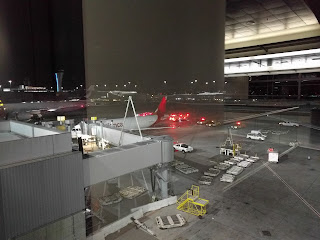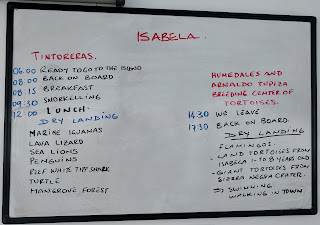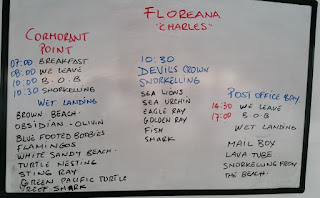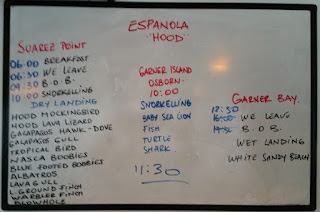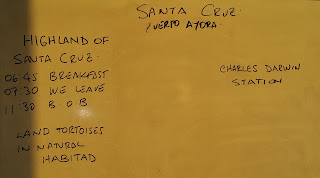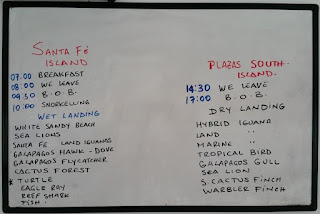For photos only, click here:
It was time to visit a new continent - South America. Two primary attractions: Galapagos Islands (Ecuador) and Machu Picchu (Peru.) You could possibly add Patagonia to the list, but that would be in lieu of visiting Antarctica.
Because Dec/Jan is rainy season in Peru, we switched our 2015 winter trip to Central America (Yucatan and Costa Rica) instead. Best time to visit Peru is July-August, but to avoid crowds, late May-early June is better.
There's never a bad time to visit Galápagos. It depends on what you want to see/experience on these islands. From crowd standpoint, peak seasons last from mid-June through early September and from mid-December through mid-January. Because the national park limits the number of visitors to each island and coordinates each ship's itinerary, the Galápagos will never feel like Disneyland. But you are likely to feel a sense of solitude and isolation. On our trip, on some islands, ours was the only boat. At most, there were 5 boats at one location, but our landing times were different.
Late May in Galapagos and early June in Peru worked out perfectly for us. No rains whatsoever, Cloudy at times, but not foggy. A bit chilly at nights and perfect 70s during days. Because the water is warmer at this time, swimming and snorkeling are more enticing. We didn't need wetsuits.
This is the breeding season for land birds in Galapagos, so it's a good time to watch some unusual mating rituals, as well as nesting - eggs and chicks being tended to. If you're into turtles, you can watch sea turtles nesting on the beach, and see land tortoises searching for mates around the lowland areas of the islands. You'll also see adorable newborn sea lion pups frolicking on beaches and in shallow waters. Another benefit of traveling to the Galápagos at this time of year: The ocean is much calmer, so less chance of getting seasick.
In general, Galapagos is expensive. For trip planning purposes, a cheaper option is to stay on one of the islands (BNB or hostels) and take day trips for sightseeing. The islands are however fairly spread out, and you may end up spending a lot more time ferrying than sightseeing.
Cruise-tours is a better option - boat travels at night to the next island (that also means less chance of seasickness), and you are parked minutes away from the sightseeing spot for the next day. We were on a double hulled catamaran. which by design is more stable whether parked or going full speed. That however creates interesting room access situation, where you have to climb wooden ladder to enter/exit your room. More on this later.
The largest cruise ship here has 60 rooms (120 people), whereas our catamaran had 7 rooms (14 people. In actuality, we had only 11), so we could all pile up in one Zodiac inflatable boat and off we went.
Cost-wise, at high end, you could pay $1000 per day, per person for Luxury Class travel - remember, your first and last day are just arrival and departure so a 10 day cruise is really only 8 days of sightseeing.
Typically, you'd have 3 two-hour activities each day - a combination of hikes and snorkeling/ swimming. Our cruise began at Baltra (the blue route) for 5 days and continued on the red route for another 3 days. Total 11 people started at Baltra. Six got off after the blue route, and five new people joined for the red route. Both groups were very happy with their own experiences. In hindsight, there was a lot of repetition on the red route for us, so it would have been just fine if we'd stopped after the blue route as well. But then again, we saw lot more nesting birds, with eggs and chicks, and did a lot more snorkeling on the red route.
What does a typical tourist to Galapagos look like? No surprise - over half (6 on the blue route and 7 on red) were from the US - of which, 4 were from California, the rest from the East Coast. Others were from Europe and Canada. A lot more younger crowd than I expected though - 10 out of total 16 in both groups were in their 30s or less - youngest being 20. Because of the small group size, we got to know each other very well. All meals were together - buffet style, on two tables side-by-side. And there was plenty of deck space to lounge around as you see in photos below.
Food was great, and so was the service. You could always do more activities, but what we were able to do and experience was plenty. Some people suffered from seasickness and/or stomach problems, but everyone was able to enjoy most of the activities just fine.
It was time to visit a new continent - South America. Two primary attractions: Galapagos Islands (Ecuador) and Machu Picchu (Peru.) You could possibly add Patagonia to the list, but that would be in lieu of visiting Antarctica.
There's never a bad time to visit Galápagos. It depends on what you want to see/experience on these islands. From crowd standpoint, peak seasons last from mid-June through early September and from mid-December through mid-January. Because the national park limits the number of visitors to each island and coordinates each ship's itinerary, the Galápagos will never feel like Disneyland. But you are likely to feel a sense of solitude and isolation. On our trip, on some islands, ours was the only boat. At most, there were 5 boats at one location, but our landing times were different.
Late May in Galapagos and early June in Peru worked out perfectly for us. No rains whatsoever, Cloudy at times, but not foggy. A bit chilly at nights and perfect 70s during days. Because the water is warmer at this time, swimming and snorkeling are more enticing. We didn't need wetsuits.
This is the breeding season for land birds in Galapagos, so it's a good time to watch some unusual mating rituals, as well as nesting - eggs and chicks being tended to. If you're into turtles, you can watch sea turtles nesting on the beach, and see land tortoises searching for mates around the lowland areas of the islands. You'll also see adorable newborn sea lion pups frolicking on beaches and in shallow waters. Another benefit of traveling to the Galápagos at this time of year: The ocean is much calmer, so less chance of getting seasick.
In general, Galapagos is expensive. For trip planning purposes, a cheaper option is to stay on one of the islands (BNB or hostels) and take day trips for sightseeing. The islands are however fairly spread out, and you may end up spending a lot more time ferrying than sightseeing.
Cruise-tours is a better option - boat travels at night to the next island (that also means less chance of seasickness), and you are parked minutes away from the sightseeing spot for the next day. We were on a double hulled catamaran. which by design is more stable whether parked or going full speed. That however creates interesting room access situation, where you have to climb wooden ladder to enter/exit your room. More on this later.
The largest cruise ship here has 60 rooms (120 people), whereas our catamaran had 7 rooms (14 people. In actuality, we had only 11), so we could all pile up in one Zodiac inflatable boat and off we went.
Cost-wise, at high end, you could pay $1000 per day, per person for Luxury Class travel - remember, your first and last day are just arrival and departure so a 10 day cruise is really only 8 days of sightseeing.
Typically, you'd have 3 two-hour activities each day - a combination of hikes and snorkeling/ swimming. Our cruise began at Baltra (the blue route) for 5 days and continued on the red route for another 3 days. Total 11 people started at Baltra. Six got off after the blue route, and five new people joined for the red route. Both groups were very happy with their own experiences. In hindsight, there was a lot of repetition on the red route for us, so it would have been just fine if we'd stopped after the blue route as well. But then again, we saw lot more nesting birds, with eggs and chicks, and did a lot more snorkeling on the red route.
What does a typical tourist to Galapagos look like? No surprise - over half (6 on the blue route and 7 on red) were from the US - of which, 4 were from California, the rest from the East Coast. Others were from Europe and Canada. A lot more younger crowd than I expected though - 10 out of total 16 in both groups were in their 30s or less - youngest being 20. Because of the small group size, we got to know each other very well. All meals were together - buffet style, on two tables side-by-side. And there was plenty of deck space to lounge around as you see in photos below.
 |
| Nemo I Catamaran - double hulled |
 |
| Nemo I - back deck - loading and dining area |
 |
| Dining |
 |
| Dining and lounging area |
 |
| Front Deck for sunbathing |
 |
| And for relaxing |
- On the way to Galapagos, we had a layover in Panama City (PTY) and visited Panama Canal Locks on May 22.
- We reached Quito (UIO) the same night and continued on to Galapagos early next morning.
- Up on return from Galapagos, we had one day (May 31) to sightsee Quito, before continuing on to Peru for 5-day Cusco / Machu Picchu adventure.
- Here are some underwater videos in Galapagos.

